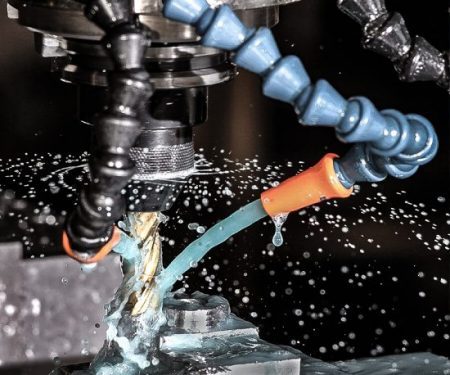Metalworking fluids may not contribute that much to your manufacturing costs, but when fluids begin to fail or not work as intended, the costs could be astronomical. With the increasing costs of more technological fluids and rising disposal costs, managing your fluid and fluid consumption is more important than ever. Managing your fluids and dedicating a fluid management program could pay dividends by: reducing fluid usage, extending tool life, and improving manufacturing performance.
Monitoring Concentration
Fluid technology has advanced by leaps and bounds over the years and have improved performance for manufacturers. However, these advanced fluids have been engineered to work at specific concentrations. Running a coolant too thin or too rich will limit its ability to do its job. Running a coolant too rich might cause problems of over lubricity, but the main problem is overconsumption of the fluid.
The big problems occur when a fluid is too thin. This means the concentration in the sump is below the manufacturer’s recommendation. The additive packages are designed based on these minimum concentrations and provide enough of each additive to perform its function properly. Less concentrate means fewer biocides, fewer rust inhibitors, fewer emulsion stabilizers, etc. Eventually, the fluid breaks down quicker requiring more frequent change-outs. Some managing fluids, some operators use coolant additives/boosts to improve performance. If you vigilantly monitor concentration, the need for additives will lessen and thus reduce costs.
To monitor concentration, use a refractometer to measure concentration frequently. It is recommended to measure concentration every day or twice a day (depending on your operating schedule). The same person should measure to ensure consistency and ensure reliable measurements. When charging or recharging sumps, using automatic mixers helps ensure concentration is consistent. Remember, do not add just coolant or just water to the sump to balance out concentration. Some facilities use digital coolant monitoring systems to manage concentration, pH, and other factors. Facilities with large coolant systems may benefit from the technology.
Assessing Water Quality
Water comprises 90% or more of the fluid in the sump, thus it is crucial to make sure you are using good water. A common problem is hard water. The ions in hard water can cause chemical instability and increase the likelihood for emulsion splitting. Testing and treating your water is recommended to make sure your sump mix is working as intended. Twin Specialties can test samples of your tap water to ensure it is suitable for use in your metalworking fluid. If your tap water is excessively hard, installing a de-ionized water line is recommended for your facility. Coolant mixers can be connected directly to these lines to ensure proper mixing.
Once your water is deemed suitable, mixing the oil and water is all that is left in preparation. For the best performance and increased emulsion stability, follow the acronym O.I.L.: oil in last. This is an easy to remember acronym that will help you manually mix coolant; automatic mixers already mix using best practices.
Monitoring pH
Alkalinity is critical in the performance of your fluid. If the pH dips too low, it will no longer work and will need to be changed out. If pH drops below 8, it is imperative to raise it immediately. If pH drops below 7, the coolant is lost and must be changed. As the coolant gets more acidic (decreasing pH) you increase your risk of rusting problems. Some additives boost pH, but those may not be needed if you actively monitor your concentration. Monitoring is relatively easy, mix the fluid in the sump to get a more homogenized solution then dip a pH testing strip into the solution. Give the strip some time to change color and then match the strip to a reference sheet (usually provided with the strips). Then you can act accordingly armed with the pH information you need.
Tramp Oil Removal
Slideways and spindles require oil lubricants in order to function properly and ensure proper machining operations. These oil lubricants will leak into the sump and can cause havoc on your metalworking fluid. Some of the lubricant will be emulsified and disrupt the chemical composition of your metalworking fluid. The more oil content in the concentrate, the more likely the tramp oil will be emulsified.
This causes the growth of anaerobic bacteria. This bacterium creates hydrogen sulfide gas, which is the “rotten egg” or “Monday morning” smell that indicates coolant rancidity. The hydrogen sulfide in water also produces acids that drive down pH and alkalinity, which further damages coolant.
Synthetic coolants are excellent in rejecting tramp oils and prevent them from being emulsified. These floating oils can easily be skimmed and removed before causing damage. Using coolants below recommended concentrations limit the tramp oil rejecting additives and can accelerate this process of degradation.
Floating tramp oil can increase oil mist and smoke formation that can damage machines. The tramp oil mist also increases residues on the machine that can clog filters and destroy critical electronic components. Removing floating oil is relatively easy. Installing a skimmer, centrifuge, and/or coalescer will remove tramp oil from the sump and extend your coolants life.
Filtration
Metal fines and chips may find their way into the sump. It is important that they do not remain there and are not cycled through the machine. These fines can cause wear and damage to the machine and workpiece. The fines can build up and create dead-zones when additives are trapped and do not work. The trapped additives cannot work and lead to accelerated coolant breakdown.
Filtration used to be a cost-prohibitive endeavor, but the economics of coolant management and consumption make filters a worthwhile tool. The costs of filtration have come down and filtration technology has improved, thus implementing them will reduce coolant consumption and coolant spending.
Removing Foreign Substances from the Sump
Dirt and other foreign substances can cause problems such as abrasion and pump damage. Filtering solid substances and removing them will improve coolant performance. Sump cleaners might not be fully removed and can cause excessive foaming. If that happens, using a defoamer should alleviate these issues. However, be sure to properly remove the cleaner before recharging the sump. Prevention and proper preparation are usually the best maintenance.
Managing Straight Oil/Neat Oil
Neat oils require much less maintenance than water soluble coolants. This is because neat oils do not require water, which is a breeding ground for bacteria, fungi, and mold. However, there are still a few things that you should do to maintain and extend fluid life. The main thing should be done is filtering metal fines. Removing these metal fines improve finishing and fluid performance.
Takeaways
Given the rising costs and improving technology of metalworking fluids, it is more important than ever to proactively manage your fluids. This can lead to extended use intervals and improved performance. Following these steps will allow your machine to get the most out of these fluids.
Twin Specialties provides a full line of metalworking fluids and additives. Additionally, our sales team will work with you to test your fluids and water to troubleshoot the problem. Contact Twin Specialties for more information about our metalworking fluids, technical expertise, and our testing and sampling program.

